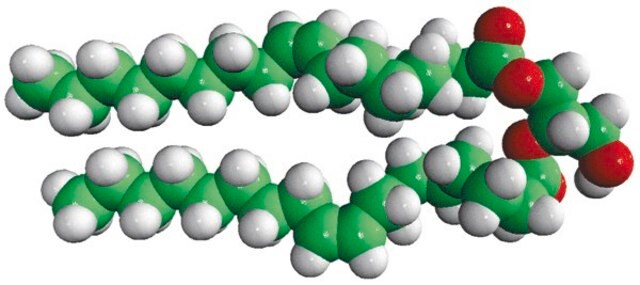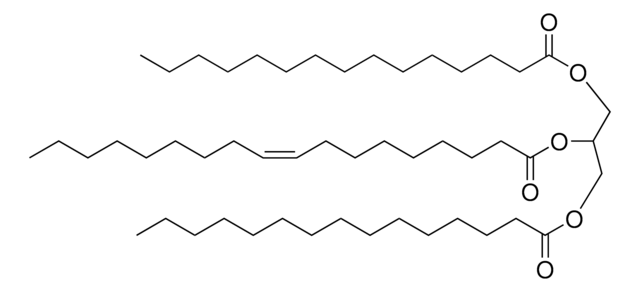800815O
Avanti
16:0-18:1 DG
1-palmitoyl-2-oleoyl-sn-glycerol, neat oil
Synonym(s):
1-hexadecanoyl-2-(9Z-octadecenoyl)-sn-glycerol; DG(16:0/18:1(9Z)/0:0)
About This Item
Recommended Products
Assay
>99% (TLC)
form
liquid
packaging
pkg of 1 × 10 mg (with screw cap (800815O-10mg))
pkg of 2 × 100 mg (with screw cap 800815O-20)0mg)
pkg of 1 × 25 mg (with screw cap (800815O-25mg))
manufacturer/tradename
Avanti Research™ - A Croda Brand 800815O
lipid type
neutral lipids
neutral glycerides
shipped in
dry ice
storage temp.
−20°C
General description
Diacylglycerol mimicks the effects of the tumor-promoting compounds phorbol esters.
Application
- in the lipid vesicle preparation for protein kinase C (PKC) activity studies
- in aqueous phospholipid dispersions for differential scanning calorimetry (DSC) analysis
- in in vitro diacylglycerol kinase assay
Packaging
Storage and Stability
Other Notes
Dry samples of diacylglycerol in chloroform, using a stream of nitrogen. Dissolve the residue in an appropriate volume of ethanol or DMSO, then dilute to the desired aqueous medium.
Most biological responses saturate at 20 to 250 μM sn-1,2-dioctanoylglycerol. Only sn-1,2 isomers appear to be active.
Legal Information
Storage Class Code
10 - Combustible liquids
Certificates of Analysis (COA)
Search for Certificates of Analysis (COA) by entering the products Lot/Batch Number. Lot and Batch Numbers can be found on a product’s label following the words ‘Lot’ or ‘Batch’.
Already Own This Product?
Find documentation for the products that you have recently purchased in the Document Library.
Our team of scientists has experience in all areas of research including Life Science, Material Science, Chemical Synthesis, Chromatography, Analytical and many others.
Contact Technical Service







